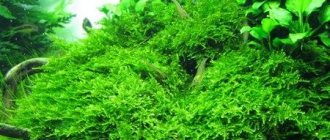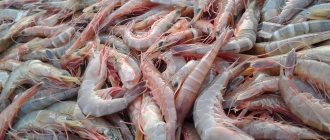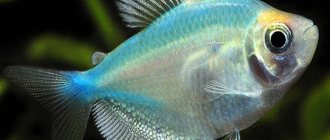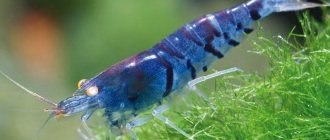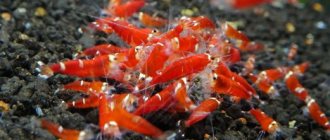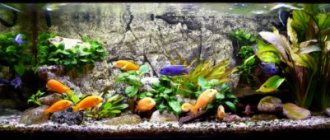By properly organizing a private fishery, you can achieve success and make a profit. The main advantages of freshwater shrimp farming include the presence of an extensive market for products, the absence of difficulties in care, and financially accessible equipment. The direction is quite new in our country, so there is no need to be afraid of high competition. Before you start implementing the idea, it is important to familiarize yourself with the features of growing shrimp.
Description
Freshwater shrimp have a special build, which is expressed in multi-leggedness. Thanks to small legs, individuals can not only move, but also perform various actions (for example, assisting in breathing). The body of freshwater shrimp is divided into a cephalothorax and an abdominal region. In the cephalothorax area the main part of the crustacean’s legs is concentrated and the eyes and antennae are located.
In the area of the peritoneum, individuals have additional legs that facilitate movement in the water surface and bearing offspring. The anterior part of the thorax segments is fused with the head. If shrimp move with their hind legs, then with their front legs they carry food to the oral cavity. The presence of a carapace allows you to protect the chest and head.
Powerful jaws are capable of crushing and crushing food. Thanks to the blade located in the jaw area, water circulates in the gills. With the help of legs on the abdominal cavity, females can hold eggs. Stalked eyes enable crustaceans to turn.
Behavior
Almost any variety of shrimp is ideal for keeping in artificial reservoirs. They do not hunt fish or nibble on plants, so they can be kept together with small, friendly fish species. Large, especially aggressive fish species perceive small shrimp as food.
A frolicking flock
If you keep both fish and shrimp together, then you should not hope that their offspring will survive, but rather, on the contrary, the fry and larvae will be completely eaten by the fish.
In addition to small freshwater shrimp, you can often find fairly large shrimp on sale in pet stores. For example, Nigerian (their description is on our website in a separate article). There is no need to worry when buying them, as their disposition is as peaceful as other breeds. However, as with any rule, there are exceptions, which include the Rosenberg breed or the chameleon.
Breeding Features
Before you start growing freshwater shrimp, it is important to study information about the features of breeding, feeding and care. In addition, you should choose a place where the crustaceans will be kept. If you wish, you can agree to rent a local pond or arrange a pond on your own property. The depth of a homemade pond should be within 1.45-1.55 m. The bottom surface of a homemade pool should be equipped with shelters for a comfortable habitat for shrimp. For these purposes you can use:
- slate parts;
- driftwood;
- roof tiles;
- pipe sections.
The water to fill the reservoir must be alive, green, and contain organic fertilizers. By following these recommendations, you can contribute to the natural creation of a food supply for crustaceans.
Important! When breeding shrimp, you should systematically monitor the pH level in the water and provide good lighting to the aquatic inhabitants.
In order for the maximum percentage of shrimp offspring to survive, it is important to strictly observe the temperature regime. It is recommended to keep the water temperature at 23-27C. Considering that shrimp farming requires maintaining warm water temperatures, we can talk about the seasonal nature of such a business. To extend the season, you should take care of artificial heating of the pond in advance. However, it is worth considering that the cost of the equipment will be high.
Shrimp should be fed with natural food, both animal and plant origin.
Growing technology
After birth, the fry are placed in a separate tank with salt water (12 ppm). Sea water can be obtained by adding a special salt mixture to the pool. The temperature regime is maintained within 27-29 degrees.
At first, the fry require very finely ground food. Alternatively, yeast, spirulina, special starter feed for young animals. After about a month, the postlarval stage begins, when the babies begin to resemble adult shrimp. This is a signal for gradual desalination of water. The salinity level is reduced by half, and they gradually switch to fresh water.
There is a transition to adult food. Grown-up shrimp are transferred to a common pool of fresh water, where their further life cycle occurs. After 6 months they are ready to breed, and after a year they can be caught for sale, since they have already gained sufficient weight (70-100 grams).
Aquarium equipment
To grow different types of freshwater shrimp, you need to buy different containers. This will avoid conflicts between individuals and prevent interspecific crossing. In order to start a business, you will need containers with a volume of 80-100 liters with the presence of:
- filter;
- lighting;
- aerator.
Growing in ponds
For residents of the southern regions, the idea of \u200b\u200bgrowing shrimp in a pond is perfect. By using heating of the reservoir in the cold season, a continuous process can be achieved. The owner of a shrimp farm must systematically add fry to the pond, whose weight has barely reached 2-3 g, and catch adults.
If you want to open a business in colder regions, you can transfer aquatic inhabitants to aquariums that are placed indoors for the winter. The process of raising wards occurs in stages:
- Finding crustaceans in aquariums concentrated indoors until the beginning of May.
- Relocation of individuals to open water in early May.
- Reaching commercial size at the end of September.
To breed shrimp, you should select a reservoir whose depth will reach 100-115 cm. The presence of moss, algae, brine shrimp, rotifers and tardigrades in the water is also important. Shrimp can be kept in water whose temperature is in the range of 20-35C. If the temperature drops a couple of degrees below the minimum limit, then the individuals stop feeding. In cold water (12-14 C) crustaceans die.
Optimal indicators for the growth and normal development of shrimp
| Oxygen content | Nitrite indicator | Nitrate level |
| 5 mg/l | 0.26-0.35 mg/l | 1.5-3 mg/l |
Exceeding the indicators leads to the extinction of the population.
RAS device
In order to create comfortable conditions for the patients under their care, experts recommend installing a closed water supply device (RAS), which should be located in a room with heating and good lighting. The basis of the RAS will be:
- A pair of swimming pools with a capacity of 1.5-2 tons of water.
- Pumps that are capable of circulating water.
- Storage containers.
- Filtration blocks.
- Aerators that help saturate the water with oxygen.
- Ultraviolet disinfection system.
Equipment
To grow in an aquarium, the entrepreneur must take care of the installation in advance:
- heating system;
- aeration systems;
- filters.
It is important to leave the aeration on around the clock, as crustaceans are highly sensitive to the level of oxygen contained in the water. The heating and lighting function should be set depending on the needs of the inhabitants of the reservoir. When installing a filtration system, it is important to ensure minimal internal flow. Each of the holes on the filter must be covered with a sponge so that crustaceans do not fall into them.
Types of freshwater shrimp
Snowflake (Neocaridina white)
One of the decorative varieties, it is difficult to confuse it with another, since it has a snow-white color, even the caviar of this crustacean creature is pure white. The snowflake is a relative of the blue pearl shrimp, both species were bred in Germany, so its color is the result of long work by breeders. The saka and the male snowflake can be distinguished by size: the female has a bright color, is larger, and the carapace on the abdomen is somewhat wider.
Harlequin (Caridina spongicola)
The natural habitat of freshwater shrimp is Indonesia. This is one of the smallest types of shrimp, they are quite shy. It lives and feeds on a freshwater sponge - with its help it eats algae and food particles. Sexual differences in shrimp are weakly expressed, since the color of males and females is the same. The color of the harlequin is variegated, mixed, white, black and red predominate. Harlequin shrimp often hide in shelters and take a long time to adapt to a new environment.
Khanka shrimp (Leander modestus)
The natural habitat of the shrimp is the Amur Estuary (Far East). Shrimp grow up to 3-5 cm, males are slightly larger than females. In some ways, these arthropods resemble crayfish. Their claws are weak and small, their mustache is long, their beak is convex, their body is transparent - fawn-gray-brown. These shrimp are excellent orderlies, hardy, active, and non-conflicting.
Cardinal
The cardinal is a very beautiful species of shrimp, the color can vary from deep red to light pink with white dots. Suitable for experienced aquarists only. The shrimp's natural habitat is the island of Sulawesi (Indonesia). In the lake, the cardinal lives among the stones, where he looks for food. The color saturation can vary; sometimes the white dots on the shrimp’s body also have a blue outline. Shrimp have white front legs - with their help, representatives of this species can move quickly.
Red bee
The bee shrimp is a direct relative of the crystal red shrimp, it was first discovered by a breeder from Japan, and has since appeared in many aquariums. The bee shrimp prefers slightly acidic water; it is sensitive to pollution and changes in water parameters. Often the Bee Shrimp (black striped) is crossed with Crystal Red.
Ninja Shrimp
This peculiarly named shrimp can quickly change colors and has mastered the “art of camouflage.” Also called the honey shrimp or Christmas shrimp, this species requires salt water to reproduce. Its natural habitat is the waters of Asia; we note right away that catching it in the wild is very problematic. Color varies depending on its habitat: a shrimp can quickly change its color from red to yellow, from blue to black or brown - this is not difficult for it. They have a high ability to imitate and easily adapt to their environment.
Japanese shrimp (Caridina japonica)
These shrimp belong to the macrobrachium family; in their homeland they prefer to live in streams and rivers with clean water. They grow up to 6-8 centimeters, their characteristic features are orangeish claws, a black line on the back with a white border, and white socks on the walking legs. The shrimp's body is brownish and translucent. This species is unpretentious, but they get along poorly with sedentary aquarium inhabitants (small ones) and often fight.
Ring shrimp (Macrobrachium assamense)
Its natural habitat is the water bodies of Nepal and Bangladesh. Males are significantly larger than smok shrimps, they grow up to 8 cm, while females only up to 6. Ring-armed shrimp have a rich marbled brown or gray pattern, and there are red-black rings on their claws - hence the name of the species. It is not advisable to keep several males together - they will conflict, and small fish or crustaceans are not suitable as neighbors.
Striped longclaw shrimp (Macrobrachium carcinus)
It lives in the rivers and streams of America, grows up to 35 cm, large specimens often conflict over territory and do not like their relatives, there is a tendency to cannibalism. The abdomen and body are painted with yellow-brown longitudinal stripes, the claws are strong, blue or brown.
Black tiger shrimp (Penaeus monodon)
The black shrimp is very beautiful, with bright orange or black eyes (the first type is more valuable). These shrimp are very sensitive to water parameters, bred as a result of long selection, and are not suitable for beginners, since their breeding requires considerable effort.
Amano (Caridina multidentata)
This shrimp is often found in aquariums and owes its name to the breeder Takashi Amano. In their natural environment, shrimp of this species live in Japan, in the south of the country. The color of crustaceans depends on what they eat: it can be reddish or transparent green, often they are almost transparent. Black lines and dots are scattered throughout the body, growing up to 3-6 cm, females are larger.
Thai glass shrimp (Macrobrachium lanchesteri, Glass shrimp)
This species of crustacean lives in the rivers of Asia and stays near the shore. Representatives of this species are very territorial and love to dig holes in the ground. They grow up to 8 centimeters, the color is transparent, there is a black stripe along the back. Males are larger, their claws are more elongated, with hair, females appear stockier. They live no more than 3 years.
There are several hundred species of freshwater shrimp; we have described only the main ones.
Providing conditions of detention
When breeding crustaceans, it is important to adhere to the basic recommendations shared by experienced shrimp farming entrepreneurs:
- There should be no wild species in a freshwater shrimp aquarium.
- It is unacceptable to keep shrimp with large fish.
- It is important to control the acidity of the water and systematically carry out measures to cleanse the reservoir.
- Monitor the level of nitrites and nitrates in the reservoir.
- Provide a rocky bottom surface.
- Keep the water temperature in the range of 25-29 C.
- Place a sufficient amount of phytoplankton in the reservoir.
- Equip a couple of aquariums that serve as an incubator for keeping females with eggs.
Nutrition
Aquarium shrimp are not picky when it comes to nutrition; almost all species are omnivores! They feed on leftover fish food, organic waste and algae. Once every few days they need to be fed with daphnia, canned and live food.
Balanced granular food for shrimp.
In addition, several shrimp feed manufacturers: Mosura Shrimp Food and BorneoWild, produce balanced feeds suitable for daily feeding. When choosing, make sure that the food does not contain more than 30% protein.
Perhaps the only difficulty in feeding shrimp is to prevent the fish from eating the food intended for arthropods. To do this, set up a shrimp feeder in a secluded place, hidden from the eyes of ever-hungry fish.
Feeders can be metal, glass or plastic. You can also use scrap materials as a shrimp feeder.
All food not eaten within 2 minutes is removed from the aquarium.
Where to get fry
Having resolved the issue with the reservoir, you should think about where you can buy the fry. You should buy small shrimp from a special farm, the organizers of which are engaged in breeding crustaceans. If possible, it is better to purchase adult females with eggs, but such an offer is difficult to come across. Therefore, the best option would be to purchase crustacean fry, the age of which has reached 12-15 days. During the first weeks, it is important to feed the postlarvae intensively so that they reach a weight of 0.25-0.35 g.
Popular questions and answers about shrimp
In this section we will answer the questions that customers often ask us.
Is it possible to buy artificially grown shrimp?
The breeding of shrimp in artificial ponds has long been practiced by residents of warm countries, who eat mainly seafood. Shrimp fry are placed in small ponds, fed and waited until they grow to the desired size. About 55% of the shrimp on the world's shelves are farmed. This makes it possible to standardize the size of shrimp and minimize fishing costs.
Farmed shrimp are also tasty and nutritious
It is impossible to answer which shrimp is better. The fact is that with a responsible approach to aquaculture breeding, the benefits and taste of artificially grown shrimp remain worthy. Considering that a significant portion of warm-water shrimp are already farmed in ponds, and only northern shrimp are caught wild, it is safe to say that farmed shrimp will only become more numerous.
What are cocktail shrimp?
These are special small shrimp that are used for pizza and salads and are one of the most popular types. Their weight in purified form does not exceed 2-3 grams.
Instructions for breeding shrimp
Below are instructions that describe the principle of shrimp farming. By following the recommendations of the instructions, you can raise large specimens of aquatic inhabitants and sell them profitably.
Settling of fry
After purchasing, we fill the bag with the fry with aquatic plants so that the shrimp can cling to them. If the purchase is made on a hot day, you should arrange for the goods to be delivered to your home. This will prevent overheating.
We place the bags with postlarvae in the water for a while and wait until the temperature in the bag and the reservoir becomes the same. In the case where there is fish in the reservoir in addition to shrimp, it is important to turn off the lighting while the fry is moving in to prevent the new inhabitants from “pecking”.
Feeding
One of the main advantages of shrimp is their omnivorous nature. She chooses for food:
- moss;
- foliage;
- seaweed;
- fish.
In case of severe hunger, freshwater shrimp can eat relatives. To avoid cannibalism, it is important to equip the surface of the bottom of the reservoir with shelters, the role of which can be played by:
- fragments of bricks;
- logs;
- a bunch of threads and green fishing line.
It is important that the diet of crustaceans contains a sufficient number of brine shrimp larvae and a specialized granulated feed mixture. Mixed feeding allows you to reduce costs. The daily diet of freshwater shrimp should be based on:
- algae;
- mixtures of milk powder and egg powder;
- flour;
- plankton;
- vitamin complex;
- minerals and fish oil.
The listed components are combined and ground. The paste is dried and cut into granules. The finished feed mixture contains more than 30% protein. Such a diet will be an excellent alternative to natural food.
How to breed shrimp correctly
In order to competently build a shrimp business, it is important to know the household preferences of pets in terms of:
- feeding;
- content;
- reproduction;
- raising offspring.
But first things first.
Feeding the shrimp
Under natural conditions, shrimp are omnivores, and it is not for nothing that they are called marine orderlies. They eat algae, fish, moss, their own discarded shells, and even their fellow creatures. But in artificial conditions, an entrepreneur needs to take care of a balanced diet. So, the shrimp diet looks like this:
- special dry food (fish food is also suitable);
- “live” food – bloodworms, Artemia larvae, tubifex, cyclops;
- chopped seafood (cod, squid, pollock);
- plant food (algae, various aquarium plants or other greens
- (spinach, nettle, burdock), pieces of vegetables and fruits processed with boiling water (carrots, pumpkin)
Food is supplied to the pool as needed, when all previous food has been eaten. It is better to remove stale remains so as not to pollute the water.
Content
In addition to water quality and constant maintenance of the microclimate on the farm, the future owner of crustaceans should know that one tank should not be too densely populated. Overpopulation is fraught with cannibalism, which will lead to a decrease in natural growth, and in the future, profits. Experts advise maintaining the following proportions in settlement - no more than 10 individuals per 1 sq. meter.
Reproduction
Shrimp reproduce successfully in captivity. Sexual maturity in individuals begins at 5 months of age. After fertilization, the females are placed in a cooler pool (temperature up to 22 degrees), where they bear offspring for 2-3 weeks. After this period, the temperature in the “shrimp maternity hospital” is raised to normal levels (27-28 degrees), and the females produce offspring.
Care
Freshwater shrimp can live not only in a large body of water, but also in a small aquarium. However, when introducing fry, it is worth remembering that the number of shrimp to keep in a reservoir is based on the calculation of 1 shrimp for every liter of water. For large breeds of crustaceans, the calculation formula changes - each individual requires 3-4 liters of water.
When the water temperature decreases, it is worth considering that the mobility of the inhabitants of the aquatic environment is significantly reduced. Too low a temperature can lead to the death of the wards.
It is important to organize water changes every 7-10 days. Compliance with this condition helps ensure the normal functioning of the inhabitants of the aquatic environment. To replace water, liquid that has been settled and heated to the required temperature should be used.
It is important to keep the water chemistry under control. The presence of copper in the composition is unacceptable.
Before settling an aquarium or pond, it is important to take care of planting:
- Java moss;
- hornwort;
- pistia;
- Cladaphora.
Timely feeding of the wards, systematic change of water and ensuring normal temperature are the main conditions that are important to observe when caring for crustaceans.
Neighborhood
For a long time it was believed that krill should not be kept with fish. However, based on my own experience, I can say that with suitable water parameters, basic care and a large amount of vegetation, krill gets along well with your favorite peaceful fish!
And the cherry shrimp can even get along with a cockerel if there is enough hiding place in the aquarium.
But you shouldn’t discount the Shrimp option either - this is a new and promising turn in modern aquarium keeping!
Shrimp are adorable and simple; with a little care, your colony will delight you for years to come! Taking care of you and your pets, Fish in a Jar!
Diseases
Shrimp are susceptible to diseases. Most often, individuals suffer from parasites that are concentrated in the shell area. Gradually, the parasites begin to penetrate muscle tissue and gills, affecting the nervous system and heart muscle. It is impossible to cure crustaceans from this disease. Individuals die quickly.
By keeping the pond clean, the possibility of fungus occurring cannot be ruled out. A fungal infection, having infected the shrimp, sucks out the nutrients from them, poisoning the crustacean’s body with toxins. Shrimp also suffer from viral diseases, which are extremely difficult to cure.
When a disease is detected in an individual, it is very important to isolate it as soon as possible. In this case, the water from the reservoir should be drained and filled with clean water. After this, you need to consult with a veterinary specialist who will help you accurately diagnose and prescribe appropriate treatment.
Possible difficulties
Shrimp reproduce during the periods between molts. The female is capable of bearing up to 18-20 eggs at a time. Small freshwater crustaceans live 12-16 months. This period is quite enough to overpopulate ponds with intensive reproduction. However, lack of proper care reduces the life expectancy of individuals. Shrimp die en masse, never reaching marketable weight. In this case, fry constantly have to be purchased from other people’s farms. In this case, financial costs increase, and profits cover maintenance costs.
Peculiarities of behavior in the natural environment and lifestyle of the giant shrimp
By their nature, giant shrimp are predatory creatures, although they do not disdain plant foods, but their hunting instincts are quite clearly expressed in them. These representatives of the crustacean family are predominantly nocturnal, preferring to sleep during the day in a secluded, shaded place, and at dusk they go hunting and search for food.
The Rosenberg shrimp is a mollusk that prefers to lead a solitary lifestyle and is always on guard, defending its territory from uninvited guests and outsiders. Moreover, unlike most other crustaceans, a representative of the stronger sex will fight for territory not only with the male, but even with the female, except during the mating period for the purpose of reproducing offspring.
But this only applies to a collision between 2 males. In their natural habitat, giant shrimp form peculiar families in which one male and several females live. With this way of life, the mollusks coexist peacefully, take care of their offspring, and the male also protects not only the territorial space, but also his small “harem” from potential danger.
Giant shrimp are very neat creatures. These clams endlessly clean themselves, removing bits of dirt and dust. However, this habit is determined not so much by a love of cleanliness, but by the fact that various kinds of pollution can negatively affect the sensitivity indicators of the Rosenberg shrimp, which it needs both for hunting and searching for food, and for orientation in space, protection from potential enemies.
Breeding Features
To make a profit from farming crustaceans, it is necessary to organize the proper conditions for the full growth of shrimp. Before purchasing expensive equipment, you should talk to entrepreneurs who are engaged in shrimp farming and study the nuances of the business. It is important to provide the wards with the proper conditions, namely:
- Comfortable water temperature, which allows the fry to quickly gain weight and develop normally.
- Limit the number of individuals in the reservoir. In an overcrowded pond, shrimp are susceptible to cannibalism.
- High-quality feed mixture. Fry should be fed frequently when they are between 10 and 15 days old. During this period, postlarvae intensively gain weight, so saving on food is not advisable. You can purchase food from a supplier or prepare it yourself.
Feeding shrimp in an aquarium
When keeping shrimp together with fish, the problem of feeding them actually does not exist, since they will happily eat up the leftovers from the fish table, but this is provided that the aquarium has a large bottom area, it is densely planted with small-leaved plants and biological balance has been established in it. Shrimps will graze on the ground and aquatic vegetation, picking up organic matter left over from the meals of other aquatic organisms. Even the excrement of fish (especially viviparous fish) and snails is used.
Shrimp eat dry fish food well, especially those intended for various catfish. They enjoy eating various frozen foods.
Currently, specialized food for crustaceans is produced (in the form of granules or tablets, for example Taiwanese Biomax No. 3 or SERA Shrimps natural granules). Of course, such food is not replaceable when keeping shrimp in a separate aquarium. Some vegetables can serve as good vegetable food for shrimp, in particular leaf spinach, zucchini, green peas, cucumbers, etc., which should be boiled for several minutes before use. Experiments with vegetables are entirely permissible, but it is necessary to monitor the shrimp’s reaction to them and promptly remove from the aquarium any food that does not suit them.
It would not be a bad idea to give the newly hatched offspring food for the fry.
At the same time, we should not forget that overfeeding animals is much more harmful than underfeeding, since in some cases this can even lead to their death. There is a general rule: feed little by little, but as varied as possible.
It is advisable to give shrimp one or two fasting days every week, during which they eat only pasture.
Shrimp farming business
You can achieve success in a difficult business only by considering in detail both the main and additional nuances of the matter. The main advantage of the farm will be an extensive sales market and the absence of difficulties in caring for individuals. By approaching the issue correctly and providing shrimp with good conditions for reproduction, you can count on high profits.
Profit and profitability
By producing 7-9 tons of crustaceans every year, you can get an income of 2-3 million rubles. At the same time, the cost of a kilogram of products should be 320-380 rubles. A business can pay for itself in 1-2 years. To determine the profitability of a shrimp farm, it is important to determine the cost per kilowatt of energy that the farm owner uses to heat water during the cold season.
If heating elements are used, then the financial costs of paying utility bills increase greatly. It is better to study the possibility of using gas in advance. The presence of a hot water discharge channel from a thermal power plant near the pond makes life easier for the entrepreneur. This advantage makes it possible to grow crustaceans even in the cold season.
Sales market
Sales organization is an important component of business. When growing crustaceans for sale, you can cooperate with:
- restaurants and sushi bars;
- beer bars;
- retail grocery stores;
- supermarkets;
- fish shops;
- pet stores.
A shrimp farm is an unusual business for our climate. However, using the knowledge and experience of foreign entrepreneurs, you can create a highly profitable business that will bring high profits.
Watch the video on the topic:
Meet the Shrimp
Everything changed when small, originally colored shrimp for keeping in an aquarium began to appear on the pet market, quite easy to care for, delighting owners with interesting behavior and a passion for constant sanitary “cleaning” of their habitat. In addition, most species of shrimp for aquariums lend themselves well to selection, which has allowed specialists and even amateurs to develop many new forms of amusing ornamental crustaceans. From that moment on, the era of mass fascination with shrimp aquariums began. No other type of pet has won so many loyal fans in a record short time (maximum ten years).
And the miniature nature of the shrimp came in handy, as it was fully in line with the fashion for creating laconic compositions where living creatures are one of the most important components. An example is a closed aquarium with shrimp, which do not even need to be fed - their food is provided by a perfectly functioning biosystem. It is noteworthy that science is still just beginning to get acquainted with the world of freshwater shrimp. All the variety of their shapes, colors, types has not been fully described.
